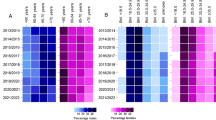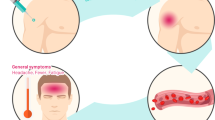Abstract
In order to determine whether there is a difference between genders in reported adverse reactions to inactivated influenza vaccine, a computerized database of serological studies was investigated. A standardized questionnaire was used to evaluate vaccine reactogenicity. A total of 1,800 vaccinees in 14 studies were analyzed separately for two age groups (<60 and ≥60 years of age). Females reported significantly more local reactions than males. The pooled odds ratio for the outcome measure “any local reaction” was 0.32 (95% confidence interval, 0.26–0.40, significant) and 0.54 (95% Cl, 0.41–0.70, significant) for young and elderly adults, respectively. Similar results were obtained for the outcome measure “any systemic reaction.” Previous exposure to influenza or influenza vaccine had no influence on reactogenicity. There were no gender differences in seroresponses. In conclusion, gender should be regarded as a predictor of reported reactions to influenza vaccine in both young and elderly adults and should be addressed in future study designs.
Similar content being viewed by others
References
Merkatz RB, Temple R, Sobel S, Kessler DA, the Working Group on Women in Clinical Trials: Women in clinical trials of new drugs. A change in Food and Drug Administration policy. New England Journal of Medicine 1993, 329: 292–296.
Centers for Disease Control: Prevention and control of influenza. Recommendations of the Immunization Practices Advisory Committee (ACIP). Morbidity and Mortality Weekly Report 1991, 40: 1–15.
Mostow SR, Eickhoff TC, Chelgren GA, Retailliau HF, Castle M: Studies of inactivated virus vaccines in hospital employees: reactogenicity and absenteeism. Journal of Infectious Diseases 1977, 136, Supplement: 533–538.
Masurel N, Laufer J: A one-year study of trivalent influenza vaccines in primed and unprimed volunteers: immunogenicity, clinical reactions and protection. Journal of Hygiene 1984, 92: 263–276.
Cate TR, Kasel JA, Couch RB, Six HR, Knight V: Clinical trials of bivalent A/New Jersey/76 — A/Victoria/75 vaccines in the elderly. Journal of Infectious Diseases 1977, 136, Supplement: 518–525.
Cate TR, Couch RB, Parker D, Baxter B: Reactogenicity, immunogenicity, and antibody persistence in adults given inactivated influenza virus vaccines — 1978. Reviews of Infectious Diseases 1983, 5: 737–747.
Govaert TME, Dinant GJ, Aretz K, Masurel N, Sprenger MJW, Knottnerus JA: Adverse reactions to influenza vaccine in elderly people: randomized double blind placebo controlled trial. British Medical Journal 1993, 307: 988–990.
Palache AM, Beyer WEP, Sprenger MJW, Masurel N, De Jonge S, Vardy A, Charpentier B, Noury J, Van Beek WCA, Borst RJA, Ligthart GJ, Keren G, Rubinstein E: Antibody response after influenza immunization with various vaccine doses: a double-blind, placebo-controlled, multi-centre, dose-response study in elderly nursing-home residents and young adults. Vaccine 1993, 11: 3–9.
Palache AM: Influenza subunit vaccine — ten years' experience. European Journal of Clinical Research 1992, 3: 117–138.
Dowdle WR, Kendal AP, Noble GR: Influenza viruses. In: Lennette EH, Schmidt NJ (ed): Diagnostic procedures for viral, rickettsial and chlamydial infections. American Public Health Association, Washington, DC, 1979, p. 585–609.
Masurel N, Ophof P, De Jong P: Antibody response to immunization with influenza A/USSR/77 (H1N1) virus in young individuals primed or unprimed for A/New Jersey/76 (H1N1) virus. Journal of Hygiene 1981, 87: 201–209.
Beyer WEP, Masurel N: Antigenic heterogeneity among influenza A(H3N2) field isolates during an outbreak in 1982/83, estimated by methods of numerical taxonomy. Journal of Hygiene 1985, 94: 97–109.
Breslow NE, Day NE: The analysis of case-control studies. Statistical methods in cancer research. Volume 1. International Agency of Research on Cancer, Lyon, 1980, p. 142.
Yusuf S, Peto R, Lewis J, Collins R, Sleight P: Beta blockade during and after myocardial infarction: an overview of the randomized trials. Progress in Cardiovascular Diseases 1985, 27: 335–371.
Nicholson KG, Tyrrell DAJ, Harrison P, Potter CW, Jennings R, Clark A, Schild GC, Wood JM, Yetts R, Seagroatt V, Huggins A, Anderson SG: Clinical studies of monovalent inactivated whole virus and subunit A/USSR/77 (H1N1) vaccine: serological responses and clinical reactions. Journal of Biological Standardization 1979, 7: 123–136.
Jennings R, Potter CW, Massey PMO, Duerden BI, Martin J, Bevan AM: Responses of volunteers to inactivated influenza virus vaccines. Journal of Hygiene 1981, 86: 1–16.
Jennings R, Smith TL, Mellersh AR, Clark A, Spencer RC, Potter CW: Antibody response and persistence in volunteers following immunization with varying dosages of a trivalent surface antigen influenza virus vaccine. Journal of Hygiene 1985, 94: 87–95.
Goodeve A, Potter CW, Clark A, Jennings R, Schild GC, Yetts R: A graded-dose study of inactivated, surface antigen influenza B vaccine in volunteers: reactogenicity, antibody response and protection to challenge virus infection. Journal of Hygiene 1983, 90: 107–115.
Beyer WEP, Teunissen MWE, Diepersloot RJA, Masurel N: Immunogenicity and reactogenicity of two doses of a trivalent influenza split vaccine. An open randomized study in healthy, unprotected, adult volunteers. Journal of Drug Therapy Research 1986, 11: 369–373.
Bachmayer H, Liehl E, Schmidt G: Preparation and properties of a novel influenza subunit vaccine. Postgraduate Medical Journal 1976, 52: 360–367.
Nathanson CA: Illness and the feminine role: a theoretical review. Social Science and Medicine 1975, 9: 57–62.
Verbrugge LM: Females and illness: recent trends in sex differences in the United States. Journal of Health and Social Behavior 1976, 17: 387–403.
Nathanson CA: Sex, illness, and medical care. A review of data, theory, and method. Social Science and Medicine 1977, 11: 13–25.
Waldron I: Sex differences in illness incidence, prognosis and mortality; issues and evidence. Social Science and Medicine 1983, 17: 1107–1123.
Author information
Authors and Affiliations
Rights and permissions
About this article
Cite this article
Beyer, W.E.P., Palache, A.M., Kerstens, R. et al. Gender differences in local and systemic reactions to inactivated influenza vaccine, established by a meta-analysis of fourteen independent studies. Eur. J. Clin. Microbiol. Infect. Dis. 15, 65–70 (1996). https://doi.org/10.1007/BF01586187
Issue Date:
DOI: https://doi.org/10.1007/BF01586187




